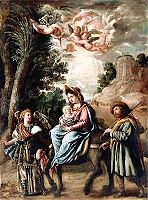 click to enlarge |
THE FLIGHT INTO EGYPTJuan de Pareja SN 339, oil on canvas, 1658 From: "The Pages" |
ARTIST:
Pareja was born in Antequera, Seville, of Muslim descent. Having requested permission from the Procurador Mayor to join his brother in Madrid to perfect his art, he was first employed by Diego Velasquez in his workshop during the 1630s, to grind colors and prepare canvases. He was called El Esclavo, the slave of Velasquez.
He accompanied Velasquez to Italy in 1649, & while there posed for his portrait; the work, entitled Juan de Pareja , hangs now in the Metropolitan Museum, NY. In it the servant/painter's dark skin and dark, curly hair indicate his origin. According to Palomino, the master made the painting as an exercise in painting a head from life before he portrayed Pope Innocent X (1649-50).
Pareja's few known works are dated between 1658 and 1669. They are eclectic in style and show the use of a warm range of color, closer to that of Juan Carreño de Miranda than of Velasquez.
SUBJECT:
Herod, as King of Judea, was alarmed at the news of the birth of a new Jewish “king.” (Matthew 2:2)To assure his own continued rule, he attempted to dispose of the infant Jesus by ordering the slaughter of all male children under the age of two. But God protected his Son by directing Joseph in a dream to flee with his family into Egypt (Matthew 2:13-15). Matthew compared this event with the slaughter of male Israelite babies at the time of Moses' birth (Exodus1:15-22).
Pareja's painting illustrates the Holy Family's journey to safety.
PAINTING:
At the top of the painting, a clutch of putti hover amongst the billowing clouds. A radiant light illuminates the figures below…Mary, holding the Christ child, rides a donkey led by an Angel. Joseph walks alongside, with their few possessions in a bundle over his shoulder. Both Mary and Joseph are dressed in clothing more contemporary than Biblical. In the background, a classical temple rises on a hill.
Despite his long association with Velasquez, de Pareja's style in this painting shows little trace of his more famous colleague's influence. Instead, Pareja looked to Italian artists of the 16th c – especially Titian – as models for both his composition and his brushwork. There are only 2 other signed paintings by de Pareja, one in the Prado, one in Huesca, Spain. Ours is the earliest of de Pareja's works.